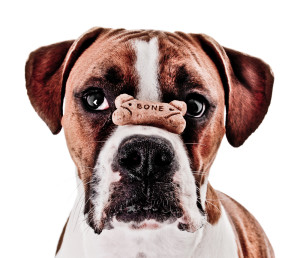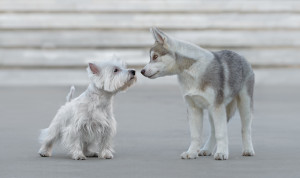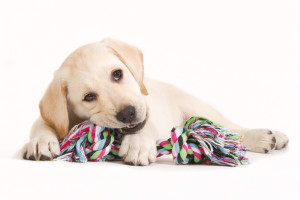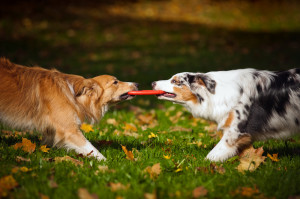 Regular exercise is known to improve the health and overall happiness of dogs. It is also capable of improving behavior, for a multitude of reasons. If your dog has behavior issues, then making sure your dog gets regular, long walks could be a way to effectively address this problem.
Regular exercise is known to improve the health and overall happiness of dogs. It is also capable of improving behavior, for a multitude of reasons. If your dog has behavior issues, then making sure your dog gets regular, long walks could be a way to effectively address this problem.
Here are a few reasons why walks are linked to better behaving pets:
Release of excess energy – The saying “a tired dog is a good dog” holds a lot of truth. A long walk allows dogs to get rid of their extra energy, making it more likely for them to rest when they are at home. Behavioral issues related to overly active breeds or chewing often subside when dogs are tired.
Improving health – Much like humans, dogs can be cranky when they are not feeling their best. Dog walking can build a stronger core in your pet, preventing common health issues like arthritis. A dog that feels well is more likely to behave well.
Socialization – Dog walking allows for a controlled setting in which your pet is introduced to new settings, smells, sounds, people, and animals. Well-socialized animals typically lack aggressive behavior, as they are not overwhelmed and frightened by external stimuli.
Mental stimulation – Your dog may become bored without mental stimulation, which can result in destructive behavior. Going on walks and presenting new situations and environments to your pup can help keep them entertained and mentally engaged.
Leash training – Using a leash is a great way to teach a pet some basic behavioral skills. Teaching your dog to become comfortable with a leash is a great first step in working with an unruly pet.
Contact an Experienced Austin Dog Walker
Regularly walking your pet is key to their health, happiness, and behavior. Finding the time to routinely walk your dog can be difficult, but Walk! ATX is here to help. From long walks to training, our Austin dog walkers can help improve your pet’s behavior keeping both them, and you, happy. To schedule an appointment, call (512) 655-9557 today.
 Teaching your dog a few simple commands is a great way to spend time with them. It also teaches obedience, and can be used to stop them from engaging in any dangerous or disobedient actions. The following four commands are fairly easy for any dog to learn, and can make communication easier between you and your pet.
Teaching your dog a few simple commands is a great way to spend time with them. It also teaches obedience, and can be used to stop them from engaging in any dangerous or disobedient actions. The following four commands are fairly easy for any dog to learn, and can make communication easier between you and your pet.
1) Sit – Teaching your dog to sit is fairly simple, so its a great command to start with. Whenever your dog is rambunctious, telling him or her to sit can help calm them down.
- Show your dog a treat at eye-level, then move the treat up towards the ceiling. When your pet watches the treat raise up, their bottom will naturally go down to a sitting position. After your pup sits, say “sit” and give him or her the treat.
2) Stay – After your dog has the sit command down, try teaching them to stay.
- Tell your dog to sit, but don’t give him or her the treat. Say “stay” and take a few steps back. If your dog stays, give him or her a treat. As your dog learns, add more distance before giving a treat.
3) Come – The come command is valuable, especially when your dog is unleashed.
- Leash your dog and lightly pull her to you after saying come, and give her a treat after she walks towards you. After mastering the trick with the leash, practice without it.
4) Down – This is a trickier command to teach, but is great if your dog tends to jump up when excited.
- Allow your dog to smell a treat in your hand, and then lower your hand towards the floor. After following your hand to the ground, pat on the ground until he lays down. Do not push him down, but if he does lay down, say “down” and offer him the treat.
Working on these commands just a few times each day will usually allow your pet to catch on. If your dog is especially stubborn, or you just can’t find the time to incorporate training into your daily routine, you may need help from a professional. Call Walk! ATX to set up a walk or training session for your furry friend by calling (512) 655-9557 today.

One of the most important things you can do when bringing your new puppy into your home is socialization. This is the act of introducing your fur baby to the world in a way that will instill confidence and positive behaviors later on in life.
So many new puppy owners aren’t familiar with this valuable training practice, and the unfortunate result can be adult dogs who are constantly afraid and who act out of that fear with aggressive behaviors.
The prime socialization time for puppies falls between their birth and sixteen weeks of age, as this is the period of development during which puppies absorb a ton of information. Unfortunately, most puppies won’t get all of their shots until they turn 15 or 16 weeks old, so your mission is to figure out how to safely expose your pup to other people and animals without risking exposure to any type of dangerous or life-threatening virus.
So, how can you avoid this and ensure that your precious pup will grow up to become a dog who greets new experiences with abundant joy instead of shivering trepidation? Start by following these simple do’s and don’ts!
Do
Bring the party to your puppy! Invite friends over to play with your puppy in the comfort and safety of your own home. You can control this environment by asking guests to remove their shoes before coming inside, allowing you to keep any contagions as far away from your precious pup as possible. Remember that variety is important! Let your dog visit with people of every shape, color, and size so that he or she can learn that all types of people are friendly. You can also ask your friends who own friendly dogs to bring them to the party so that your pup can learn how to be a good playmate for other dogs.
Don’t
Let your puppy walk in public places before all of the requisite vaccinations are administered. Most puppy-borne illnesses are contracted via contact with viruses in fecal matter or other bodily fluids. This usually happens when a puppy steps in something and licks his or her paws later. While walking is a no-no for your pup, it’s completely safe for you to carry your fuzzbundle wherever you want!
At Walk! ATX, our dog people want to help you give your pet the attention and care he or she needs. To learn more about our walking, training, or sitting services, call us at (512) 655-9557 today!
 If you have ever raised a puppy or are currently in the process of doing so, you probably understand the trials and tribulations of puppy nipping. This mouthing is an essential part of development for your puppy, however that doesn’t mean you have to be your pup’s personal chew toy. In fact, there are several things you can do if your dog’s mouthing has become a problem!
If you have ever raised a puppy or are currently in the process of doing so, you probably understand the trials and tribulations of puppy nipping. This mouthing is an essential part of development for your puppy, however that doesn’t mean you have to be your pup’s personal chew toy. In fact, there are several things you can do if your dog’s mouthing has become a problem!
Let your puppy know he is hurting you when he bites
This may sound silly, but actually yelping and speaking your puppy’s language to let him know that his biting hurts you will help him understand that biting a human is bad. Your new dog is used to playing with his littermates where biting is a common and encouraged part of the game. By imitating the sound of a hurt dog while simultaneously stopping playtime, your puppy can more clearly interpret what he did wrong.
Replace your hand or arm with a dog toy
This technique of replacing your body with a chew toy shows your dog what types of objects are appropriate to nibble on. You can slowly remove your arm or hand from your puppy’s jaws and replace it with her favorite dog toy. Another trick is having an assortment of puppy toys with different textures around. This will stop her from getting bored and moving on to chew on your favorite pair of shoes.
Use a bitter tasting spray
You can find different kinds of sprays at your local pet shop that are designed to deter dogs from chewing. Bitter apple sprays are a common, harmless spray that tastes gross to puppies. By spraying this on your hand and letting your furry friend nibble on you, he’ll quickly realize you are no longer a desirable chew toy. These sprays can also work on furniture and other items you want to keep safe from your mouthy pup.
Use your words
Some pet owners find that using a command works well to communicate to their puppies to stop chewing. “Leave it” is a common phrase that signals your dog to stop biting. By having a command at the ready, you can avoid the mistake of yelling at your puppy or using physical force.
Training a new puppy can be difficult when they enter into the mouthing stage. Fortunately, the dog walkers and trainers at Walk! ATX can help your new puppy with his or her manners, teaching new pet owners how to work with their furry companions. If you are interested in our dog walking, dog training, or pet sitting services, please call (512) 655-9557 today! Our pet-loving team would be happy to speak with you about your doggy needs.
 The best time to socialize any dog is when it’s a puppy and still receptive to new people and things. However, that’s not always possible, especially if you adopt / rescue your dog as an adult. Bringing an adult dog home can be a stressful experience if you aren’t sure what degree of socialization they have had up to that point. Fortunately, if you do find that your dog isn’t comfortable around others, there are steps you can take to socialize your adult dog.
The best time to socialize any dog is when it’s a puppy and still receptive to new people and things. However, that’s not always possible, especially if you adopt / rescue your dog as an adult. Bringing an adult dog home can be a stressful experience if you aren’t sure what degree of socialization they have had up to that point. Fortunately, if you do find that your dog isn’t comfortable around others, there are steps you can take to socialize your adult dog.
Take Daily Walks
By taking your dog for daily walks, you will help him or her get used to the presence of other people or animals. If you dog is reactive or unfriendly don’t force him or her to socialize. Instead, try and help your pup get used to the presence of others while walking. You can also help build positive associations by bringing treats with you on your walk. If your dog is reactive towards other dogs, give your dog treats as soon as you see another dog coming. However, only treat your dog if he or she is behaving and not barking or growling. As long as your dog behaves politely, continue to treat him or her until the dog passes. If you are consistent with this training, your dog will come to associate other dogs with rewards, and help him or her warm up to these other animals.
Walk Near Dog Parks
Taking your dog into a dog park might be too much if he or she was not socialized as a puppy, but walking your dog near the fence of a dog park is a good, safe first step. Your dog can get used to the sights, smells, and sounds of a dog park, and see other dogs interacting safely and politely, which could be a good eventual gateway for your dog to join in the fun.
Arrange Play Dates with Well-Behaved, Polite Dogs
If you have a friend or family member with a polite, well-behaved dog, you may want to arrange a play date to see how your dog gets along with others. Often times, it’s best to find an older dog that is non-reactive, who will be patient with your dog if he or she is poorly behaved. If you are really concerned about your dog’s reactions, you may want to consider muzzling your dog for the initial meeting.
At Walk! ATX, we have experience handling dogs of any socialization level, and can help provide you with specific advice tailored to help you socialize your puppy or adult dog. Learn more about the services we offer by calling us today at (512) 655-9557.
 Dogs are extremely social creatures, but that doesn’t mean that owners can assume that their dog will be comfortable around other people, animals, and even objects, without any additional assistance. The reality is that properly socializing a dog is an extremely important undertaking that all pet owners need to take seriously. While there are definitely things you can do to properly socialize an older dog, one of the easiest ways to socialize your pup is to do so while they’re still young and eager to learn! Here are just a few tips for things you should keep in mind when looking to properly socialize a young dog.
Dogs are extremely social creatures, but that doesn’t mean that owners can assume that their dog will be comfortable around other people, animals, and even objects, without any additional assistance. The reality is that properly socializing a dog is an extremely important undertaking that all pet owners need to take seriously. While there are definitely things you can do to properly socialize an older dog, one of the easiest ways to socialize your pup is to do so while they’re still young and eager to learn! Here are just a few tips for things you should keep in mind when looking to properly socialize a young dog.
Meeting Other Dogs
To help keep your pup happy and safe later on, it’s important to help your puppy meet a variety of dogs of various breeds, sizes, and temperaments so that they can become comfortable interacting with all different kinds of dogs. However, this does not mean just taking your puppy to any dog park and hoping for the best. You need to be extremely intentional with the dogs your dog meets early on, as you want to make sure that all meetings and interactions are healthy, positive ones that will breed trust in your dog. As such, you first need to make sure your dog, especially if he/she isn’t fully vaccinated, is only meeting fully vaccinated dogs. This can help prevent your pup from picking up a potentially deadly disease, like Parvo. Additionally, you want to make sure that the dogs your puppy meets early on are friendly and well-socialized themselves. If you have friends of family members with calm, well-mannered dogs that won’t overreact to a puppy that is overflowing with energy, that is a great place to start! Safe interactions with other well-socialized dogs will make positive associations in your pup, and will help train your dog how to act around other dogs!
Meeting Other People
Just because your pup loves you doesn’t mean that all people are immediately ok. In fact, dogs respond very differently to people based on age, height, gender, what they’re wearing, and their movements / interactions with the dog. As such, it’s very important for your young pup to meet as many new people as possible while they’re still young. However, just like meeting other dogs, this needs to be done intentionally. Make sure that your pup is comfortable meeting new people, and if he/she seems scared, don’t force it. Additionally, introducing your puppy to kids at a young age is very important, but make sure that the kids your puppy first meets are calm, and behave around your dog properly. Children that are running and screaming, or who aren’t gentle with your puppy, could end up creating more fear than comfort.
Meeting New, Scary Things
As strange as it may sound, it’s important to introduce your dog to “things” that it might come across in the course of its life, but that might not be part of its daily routine. Things like wheelchairs, crutches, skateboards, and bicycles are all things that your dog might encounter at one time or another, and so it’s a good idea to test your dog’s temperament around loud, potentially scary objects, and reward them with treats when they don’t react. This can make venturing into unknown situations in the future much more safe and calm for both you and your pup!
Here at Walk! ATX, we have experience helping dogs of all ages with proper socialization, and are happy to provide advice and instruction for both puppies and adult dogs that are in need of a little help. If you are looking to properly socialize your dog with people or other animals, give us a call and we’d be happy to help!